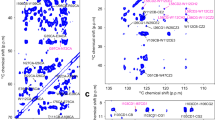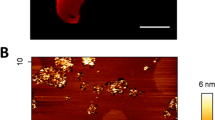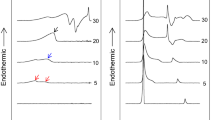Abstract
Lecithin is a major structural component of biological membranes1,2. Because of their amphipathic nature, lecithin and related phospholipids tend to aggregate as bilayer structures in which the hydrophilic head groups are orientated towards the surface and the hydrophobic hydrocarbon chains towards the interior. A detailed knowledge of the three-dimensional structure of lecithins will aid in the understanding of their role in membrane structure and function, but is still lacking. To this end we have now crystallised and solved the molecular structure of 1,2-dimyristoyl-sn-glycero-3-phosphorylcholine (DMPC), a lecithin species in the naturally occurring configuration. This compound crystallises from a water-containing solution, with two water molecules (5% w/w) of hydration.
This is a preview of subscription content, access via your institution
Access options
Subscribe to this journal
Receive 51 print issues and online access
$199.00 per year
only $3.90 per issue
Buy this article
- Purchase on Springer Link
- Instant access to full article PDF
Prices may be subject to local taxes which are calculated during checkout
Similar content being viewed by others
References
Rouser, G., Nelson, G. J., Fleischer, S. & Simon, G. in Biological Membranes Vol. 1 (ed. Chapman, D.) 5–69 (Academic, New York, 1968).
Singer, S.J. & Nicolson, G.L. Science 175, 720–731 (1972).
Tardieu, A., Luzzati, V. & Reman, F. C. J. molec. Biol. 75, 711–733 (1973).
Janiak, M. J., Small, D. M. & Shipley, G. G. Biochemistry 15, 4575–4580 (1976).
Hitchcock, P.B., Mason, R., Thomas, K.M. & Shipley, G.G. Proc. natn. Acad. Sci. U.S.A. 71, 3036–3040 (1974).
Elder, M., Hitchcock, P., Mason, R. & Shipley, G.G. Proc. R. Soc. London A354, 157–170 (1977).
Hauser, H., Pascher, I. & Sundell, S. J. molec. Biol. (in the press).
Abrahamsson, S., Dahlén, B., Löfgren, H. & Pascher, I. Prog. Chem. Fats 16, 125–143 (1978).
Pascher, I. & Sundell, S. Chem. Phys. Lipids 20, 175–191 (1977).
Sundaralingam, M. & Jensen, L. H. Science 150, 1035–1036 (1965).
Hauser, H., Guyer, W., Levine, B., Skrabal, P. & Williams, R.J.P. Biochim. biophys. Acta 508, 450–463 (1978).
Seelig, J. Q. Rev. Biophys. 10, 353–418 (1977).
Seelig, J. & Brown, J. L. FEBS Lett. 92, 41–44 (1978).
Porter, N. A., Wolf, R. A. & Nixon, J.R. Lipids 14, 20–24 (1979).
Abrahamsson, S. & Pascher, I. Acta crystallogr. 21, 79–81 (1966).
DeTitta, G. T. & Craven, B. M. Acta crystallogr. B29, 1354–1357 (1973).
Sundaralingam, M. Ann. N.Y. Acad. Sci. 195, 324–355 (1972).
Author information
Authors and Affiliations
Rights and permissions
About this article
Cite this article
Pearson, R., Pascher, I. The molecular structure of lecithin dihydrate. Nature 281, 499–501 (1979). https://doi.org/10.1038/281499a0
Received:
Accepted:
Issue Date:
DOI: https://doi.org/10.1038/281499a0
This article is cited by
-
Penicillium raperi, a species isolated from Colorado cropping soils, is a potential biological control agent that produces multiple metabolites and is antagonistic against postharvest phytopathogens
Mycological Progress (2022)
-
Bicontinuous cubic phases in biological and artificial self-assembled systems
Science China Materials (2020)
-
The effect of H3O+ on the membrane morphology and hydrogen bonding of a phospholipid bilayer
Biophysical Reviews (2018)
-
Atomistic simulation studies of the α/β-glucoside and galactoside in anhydrous bilayers: effect of the anomeric and epimeric configurations
Journal of Molecular Modeling (2014)
-
Orientation and conformation of lipids in crystals of transmembrane proteins
European Biophysics Journal (2013)
Comments
By submitting a comment you agree to abide by our Terms and Community Guidelines. If you find something abusive or that does not comply with our terms or guidelines please flag it as inappropriate.



